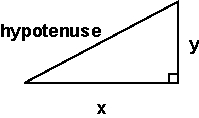
 |
|
How Fast Is The Jet Propulsion Laboratory's Station Moving?Concepts
Materials
Required skills
BackgroundThe Southern California Integrated GPS Network (SCIGN) is a series of GPS receivers that continuously record information transmitted via radio waves by 24 satellites orbiting the earth. This information is collected and processed by scientists at JPL in order to determine the receivers' positions every day. This data is then plotted on a graph called a time series, which shows an individual receiver's position (y-axis) over time (x-axis.) By fitting a line to the data points and calculating the slope of the line, the velocity (a change in distance over a change in time) of a station can be determined. The time series supplies the calculated velocity for each of the position coordinates (latitude, longitude, height,) including error. If the slope were not supplied, it could still be determine by taking the rise (movement in one direction) over the run (time.) The time series also gives the station name, and the repeatability, the average change in the position over the total time. Scientists can use this information to determine how a station is moving and simultaneously deduce what deformation is occurring in the Southern California crust. This is helpful in pinpointing areas that are deforming (straining) faster, which may mean an increased seismic risk. Hopefully, in the near future, the models made from the data collected by the SCIGN network will assist in determining aftershock risk areas following major earthquakes; lead to preventative measures limiting the destruction of buildings and property and advance the understanding of the earthquake process in Southern California. Time series of all the SCIGN stations
can be obtained via the SCIGN Analysis Homepage, located at http://milhouse.jpl.nasa.gov/scign
Helpful Formulas

ProcedureBelow is a plot of the JPL station, JPLM. Examine the figure, and answer the questions following the plot. Click on the image to see a larger version. 1. What is the station name? 2. What is the latitude rate? 3. What direction is that? 4. What is the longitude rate? 5. What direction is that? 6. What is the vertical rate? 7. What direction is that? 8. How long has this station been recording data (according to the plot)? 9. What can you say in general about this station?
Challenge:1. Using the rate values found in
questions 2 and 4, for the latitude and longitude, and the Pythagorean
theorem, solve for the overall horizontal velocity of the station (the
hypotenuse.)
2. Now try the same calculation on
another station of your choice (see URL in Materials section for
additional time series.) Questions to Answer
What
is SCIGN?
|
 |
 |
 |
 |
 |
Last modified on 10/15/98 by Maggi Glasscoe (scignedu@jpl.nasa.gov)